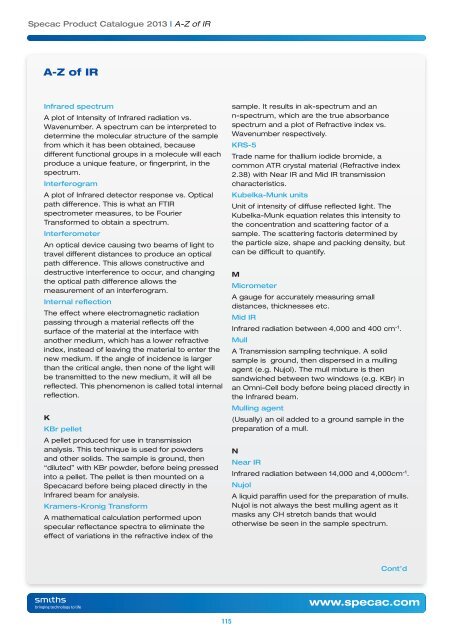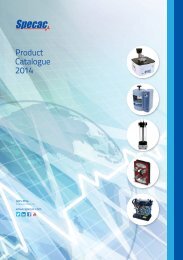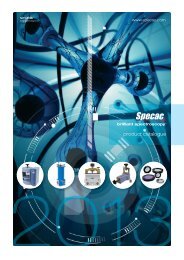Specac Catalogue 2013
Create successful ePaper yourself
Turn your PDF publications into a flip-book with our unique Google optimized e-Paper software.
<strong>Specac</strong> Product <strong>Catalogue</strong> <strong>2013</strong> | A-Z of IR<br />
A-Z of IR<br />
Infrared spectrum<br />
A plot of Intensity of Infrared radiation vs.<br />
Wavenumber. A spectrum can be interpreted to<br />
determine the molecular structure of the sample<br />
from which it has been obtained, because<br />
different functional groups in a molecule will each<br />
produce a unique feature, or fingerprint, in the<br />
spectrum.<br />
Interferogram<br />
A plot of Infrared detector response vs. Optical<br />
path difference. This is what an FTIR<br />
spectrometer measures, to be Fourier<br />
Transformed to obtain a spectrum.<br />
Interferometer<br />
An optical device causing two beams of light to<br />
travel different distances to produce an optical<br />
path difference. This allows constructive and<br />
destructive interference to occur, and changing<br />
the optical path difference allows the<br />
measurement of an interferogram.<br />
Internal reflection<br />
The effect where electromagnetic radiation<br />
passing through a material reflects off the<br />
surface of the material at the interface with<br />
another medium, which has a lower refractive<br />
index, instead of leaving the material to enter the<br />
new medium. If the angle of incidence is larger<br />
than the critical angle, then none of the light will<br />
be transmitted to the new medium, it will all be<br />
reflected. This phenomenon is called total internal<br />
reflection.<br />
K<br />
KBr pellet<br />
A pellet produced for use in transmission<br />
analysis. This technique is used for powders<br />
and other solids. The sample is ground, then<br />
“diluted” with KBr powder, before being pressed<br />
into a pellet. The pellet is then mounted on a<br />
<strong>Specac</strong>ard before being placed directly in the<br />
Infrared beam for analysis.<br />
Kramers-Kronig Transform<br />
A mathematical calculation performed upon<br />
specular reflectance spectra to eliminate the<br />
effect of variations in the refractive index of the<br />
115<br />
sample. It results in ak-spectrum and an<br />
n-spectrum, which are the true absorbance<br />
spectrum and a plot of Refractive index vs.<br />
Wavenumber respectively.<br />
KRS-5<br />
Trade name for thallium iodide bromide, a<br />
common ATR crystal material (Refractive index<br />
2.38) with Near IR and Mid IR transmission<br />
characteristics.<br />
Kubelka-Munk units<br />
Unit of intensity of diffuse reflected light. The<br />
Kubelka-Munk equation relates this intensity to<br />
the concentration and scattering factor of a<br />
sample. The scattering factoris determined by<br />
the particle size, shape and packing density, but<br />
can be difficult to quantify.<br />
M<br />
Micrometer<br />
A gauge for accurately measuring small<br />
distances, thicknesses etc.<br />
Mid IR<br />
Infrared radiation between 4,000 and 400 cm-1 .<br />
Mull<br />
A Transmission sampling technique. A solid<br />
sample is ground, then dispersed in a mulling<br />
agent (e.g. Nujol). The mull mixture is then<br />
sandwiched between two windows (e.g. KBr) in<br />
an Omni-Cell body before being placed directly in<br />
the Infrared beam.<br />
Mulling agent<br />
(Usually) an oil added to a ground sample in the<br />
preparation of a mull.<br />
N<br />
Near IR<br />
Infrared radiation between 14,000 and 4,000cm-1 .<br />
Nujol<br />
A liquid paraffin used for the preparation of mulls.<br />
Nujol is not always the best mulling agent as it<br />
masks any CH stretch bands that would<br />
otherwise be seen in the sample spectrum.<br />
Cont’d<br />
www.specac.com




